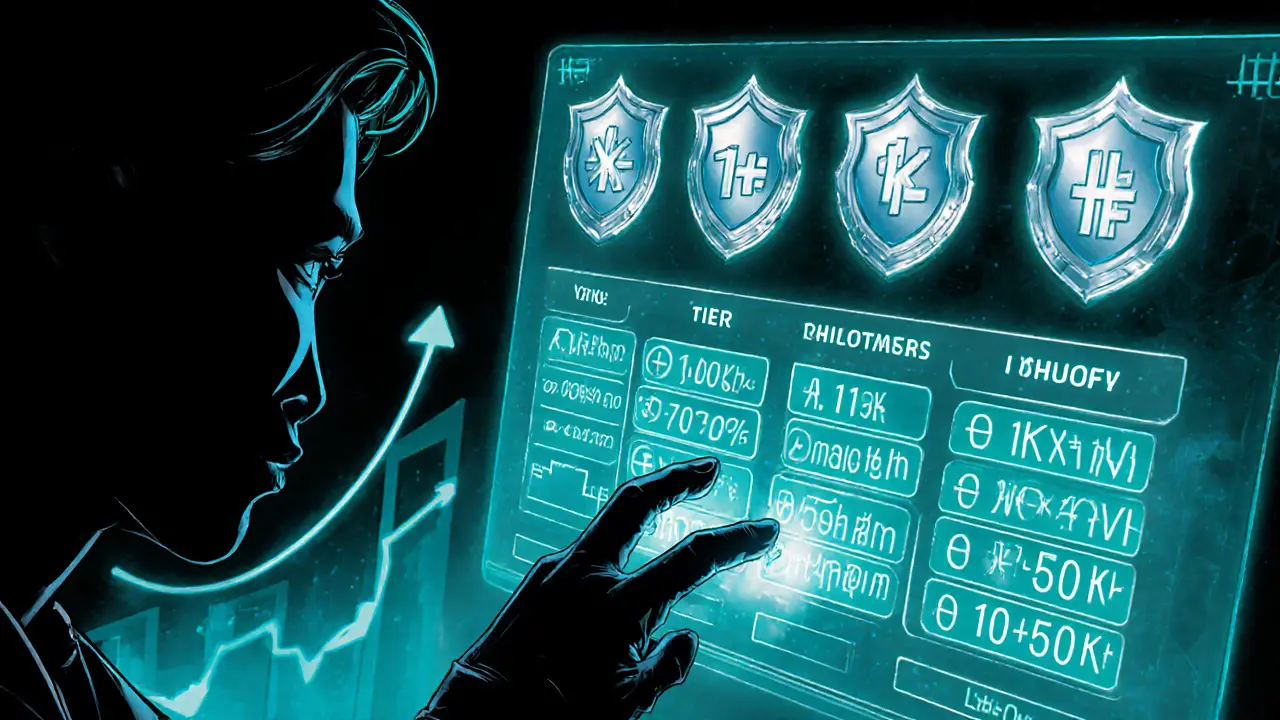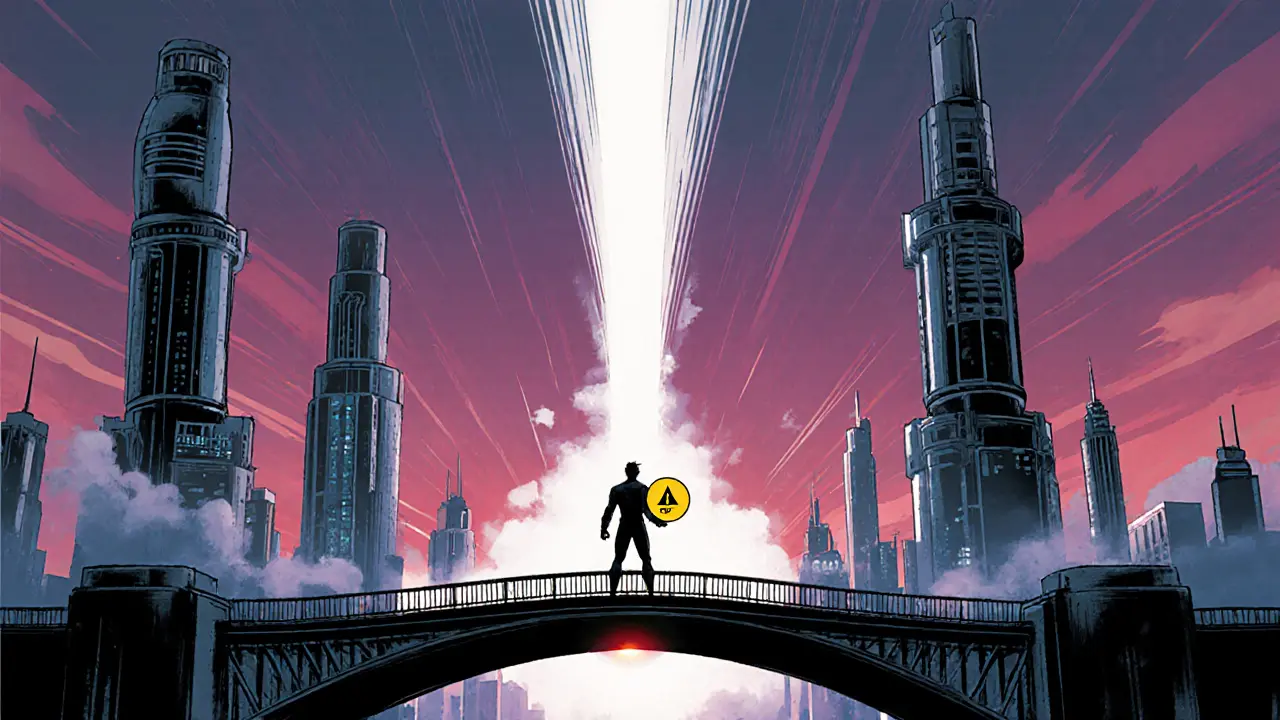Sator (SAO) Crypto Coin Explained: Tokenomics, Staking & Watch‑to‑Earn
Sator (SAO) Staking Calculator
Token Information
Total Supply: 500,000,000 SAO
Circulating Supply: 54,910,000 SAO
Current Price: $0.000273
Staking Tiers:
- 1K-10K SAO: 1.1x multiplier
- 10K-50K SAO: 1.25x multiplier
- 50K-200K SAO: 1.5x multiplier
- 200K+ SAO: 2.0x multiplier
Calculator Inputs
Estimated Rewards
Enter values and click "Calculate Rewards" to see estimated earnings.
TL;DR
- Sator (SAO) is a watch‑to‑earn token that runs on Ethereum and Solana.
- Fixed supply of 500million, with ~55million circulating.
- Staking unlocks reward multipliers and boosts earnings.
- Price fell >99% from its 2021 peak, hovering around $0.00027.
- Future price forecasts are speculative; adoption hinges on content partnerships.
What is Sator (SAO)?
Sator (SAO) is a decentralized content platform token that rewards viewers for watching TV and streaming shows. The idea is simple: watch a program, earn crypto, and let creators grow their audience at the same time. The token launched in 2021 and markets itself as the first bridge between traditional linear media and blockchain‑based engagement.
The platform’s core promise is to align the interests of two groups that usually pull in opposite directions - viewers who want free or cheap entertainment, and content owners who chase higher engagement and subscription numbers. By handing out SAO tokens for every minute watched, Sator hopes to turn passive viewership into an active, revenue‑generating activity.
How does the platform work?
At its heart, Sator is a dual‑chain application. It lives on both Ethereum and Solana, linked together by the Wormhole bridge. This setup lets users move SAO tokens between the two networks without losing value, giving them the flexibility to choose the chain with lower fees or faster confirmation times.
When you open the Sator app, you connect a compatible wallet, select a show, and start watching. The platform tracks your watch time, then automatically credits a fraction of SAO to your address. Those tokens can be held, transferred, or staked for higher earnings. The system also integrates a dedicated NFT marketplace where shows launch limited‑edition NFTs that unlock extra perks - like behind‑the‑scenes access or exclusive chat rooms.
Tokenomics and Supply
Sator’s token economics are laid out in a fairly transparent way. The total supply is capped at 500million SAO, meaning no new tokens will be minted after the initial allocation. Here’s how those tokens were split:
- 39.36% (≈196.8M) - private and pre‑sale rounds
- 0.34% (≈1.7M) - public sale
- The remaining tokens are reserved for ecosystem incentives, team vesting, and future partnerships.
As of October2025, only about 54.91million SAO are circulating. The rest stay locked in treasury wallets, waiting for release according to the project’s roadmap. Because the supply is fixed, price movements are driven primarily by demand from viewers, investors, and the occasional speculative trader.

Staking, Rewards & Multipliers
Staking is the main lever Sator uses to keep token holders engaged. Users can lock up a chosen amount of SAO, and the platform rewards them with a multiplier that applies to all future watch‑to‑earn activity. The more you stake, the higher the multiplier - a classic “hold‑to‑earn” incentive.
Staking tiers look roughly like this:
- Tier1: 1K-10K SAO - 1.1× multiplier
- Tier2: 10K-50K SAO - 1.25× multiplier
- Tier3: 50K-200K SAO - 1.5× multiplier
- Tier4: 200K+ SAO - 2.0× multiplier
Multipliers apply not only to watch rewards but also to NFT drops and referral bonuses. Stakers can withdraw at any time, though the platform nudges users toward long‑term commitments by offering lower fees for longer lock‑up periods.
Market Performance & Price History
Sator’s price story reads like many meme‑era tokens: a meteoric rise followed by a crushing fall. The token launched its IDO on 22Oct2021 at $0.044, quickly climbing to an all‑time high of $0.2654 on 13Nov2021. Since then, the market has stripped away more than 99% of that value. The current price (Oct2025) sits around $0.000273.
Despite the slump, the token still shows decent activity. A 24‑hour trading volume of $25.3K against a market cap of roughly $15K yields a volume‑to‑market‑cap ratio above 150, suggesting that the few remaining holders trade fairly actively. The community size is tiny - 239 wallets - but those participants tend to be highly engaged, often posting in Sator’s Discord about new show launches and staking strategies.
Comparison with Similar Watch‑to‑Earn Tokens
| Feature | Sator (SAO) | Theta (THETA) | Livepeer (LPT) |
|---|---|---|---|
| Primary Chain(s) | Ethereum & Solana (via Wormhole) | Ethereum | Ethereum |
| Reward Model | Watch‑to‑earn + staking multipliers | Video streaming bandwidth sharing | Live video transcoding services |
| Total Supply | 500M (fixed) | 1B (inflationary) | 1B (inflationary) |
| Current Price (Oct2025) | $0.000273 | $0.18 | $0.03 |
| Community Size | ~239 holders | ~100K holders | ~70K holders |
While Theta and Livepeer focus on infrastructure - bandwidth and transcoding - Sator tries to change the consumer side of the equation. That makes it unique, but also harder to gain traction because it needs both content partners and a viewer base willing to install a new app.
Risks, Challenges & Outlook
The biggest hurdle for Sator is adoption. Without a steady stream of popular shows, viewers have little incentive to watch and earn. The platform’s success therefore leans heavily on securing licensing deals with studios or broadcasters. So far, the team has announced a few niche partnerships, but nothing on the scale of Netflix or Disney+.
Technical complexity adds another layer of risk. Running on two chains means developers must maintain compatibility with both Ethereum’s gas model and Solana’s high‑throughput architecture. Any bug in the Wormhole bridge could freeze token transfers, eroding user confidence.
Regulatory uncertainty looms over all reward‑based crypto projects. Some jurisdictions treat watch‑to‑earn tokens as securities, which could trigger compliance costs or even bans. Sator’s team has not publicly disclosed a legal framework, so investors should stay alert.
On the upside, the broader entertainment industry is slowly experimenting with blockchain. If major networks start offering crypto‑backed fan incentives, Sator could become a ready‑made solution. Price forecasts for 2026 - ranging between $0.00013 and $0.00053 - assume that kind of partnership wave. Those numbers represent a potential 200% upside from today, but they remain speculative.
Next Steps for Interested Users
- Set up a non‑custodial wallet that supports both Ethereum and Solana (e.g., MetaMask + Phantom).
- Buy a modest amount of SAO on a reputable DEX; the token is low‑priced, so start small.
- Stake at least 10K SAO to unlock the 1.25× reward multiplier.
- Follow Sator’s official Discord and Twitter for new show drops and NFT releases.
- Keep an eye on regulatory news in your country to avoid surprise compliance issues.

Frequently Asked Questions
What can I do with SAO tokens?
You can hold them as a speculative asset, stake them to boost your earnings, trade them on DEXes, or spend them in the Sator NFT marketplace for exclusive content perks.
Is Sator safe to use?
The platform runs on established blockchains and uses the Wormhole bridge, which has been audited, but no crypto project is risk‑free. Users should only invest what they can afford to lose.
How are rewards calculated?
Rewards are proportional to watch time and are multiplied by any staking tier you hold. For example, a Tier2 staker earns 1.25 times the base reward per minute watched.
Can I move SAO between Ethereum and Solana?
Yes, the Wormhole bridge lets you transfer SAO tokens across the two chains with a small fee.
What’s the future outlook for Sator?
The project’s success hinges on securing more content partners and navigating regulatory scrutiny. If it manages both, analysts see a possible price rebound, but the risk remains high.
In a nutshell, Sator cryptocurrency is an ambitious attempt to turn TV watching into a revenue stream using blockchain. It offers a clear token model, cross‑chain flexibility, and a staking system that rewards loyalty. However, the massive price drop, limited audience, and partnership challenges mean it’s still a high‑risk play. Anyone considering SAO should weigh the novelty against the volatility and keep an eye on how the entertainment industry adopts crypto incentives.






21 Comments
Bobby Ferew
May 1 2025While the SAO tokenomics boast a fixed 500 million supply, the real lever is the staking multiplier matrix, which mirrors liquidity mining architectures seen in DeFi. By allocating just 10 K SAO you unlock a 1.25× boost, effectively turning passive watch time into an amplified yield stream. The cross‑chain bridge adds a layer of asset portability, but also introduces a latency vector that can erode net APR. Investors should model the reward curve against gas fees on both Ethereum and Solana to gauge true profitability.
Overall, the protocol’s core design hinges on user‑driven engagement metrics rather than traditional mining incentives.
Evie View
May 1 2025The price collapse from $0.265 to $0.00027 feels like a textbook case of speculative over‑extension, yet the team still pushes staking tiers like a carrot on a stick. Tier 4’s 2× multiplier is marketed as a hedge, but without a robust content pipeline the upside is purely theoretical. Moreover, the token’s volume‑to‑market cap ratio, while impressive, masks the fact that a handful of whales dominate the remaining supply. If the ecosystem can’t secure mainstream licensing deals soon, the tokenomics will remain an academic exercise.
Bottom line: hype without delivery is a zero‑sum game.
Sidharth Praveen
May 2 2025Staking on Sator can actually be a fun experiment for crypto newcomers looking to see returns in real time. Start with the modest 1 K tier to get a feel for the multiplier, then gradually scale up as you notice the watch‑time rewards compound. The cross‑chain flexibility means you can shift between Ethereum’s security and Solana’s low fees depending on market conditions. Keep an eye on the bridge’s health status; a smooth transfer keeps your earnings flowing.
Jan B.
May 3 2025Sator’s token distribution is transparent and the staking tiers are clearly defined. The 1.1× multiplier for Tier 1 provides a modest incentive for small holders. Larger stakes benefit from the 1.5× and 2× multipliers, which can meaningfully boost earnings. Users should monitor gas costs as they impact net rewards.
MARLIN RIVERA
May 3 2025The watch‑to‑earn premise suffers from an inherent incentive misalignment; viewers are rewarded for consumption rather than creation, which limits organic growth. Without a solid pipeline of premium content, the token utility plateaus quickly. The dual‑chain approach adds complexity without clear benefit, especially when bridge fees can erode marginal gains. In short, the model feels like a revenue gimmick rather than a sustainable ecosystem.
Debby Haime
May 4 2025Jumping into SAO staking now could position you for a rebound if the platform lands a few big‑name shows. Even a low‑tier multiplier adds a little extra on top of the base reward, and that little extra compounds over time. Pair your staking with the NFT drops to unlock exclusive perks – it’s a win‑win. Stay active in the Discord for early‑access alerts.
Courtney Winq-Microblading
May 5 2025When you think about watching TV as a labor transaction, the philosophical shift is striking – you’re essentially monetizing attention. Sator tries to quantify that attention into SAO, turning every minute into a micro‑economy. The elegance lies in the simplicity: watch, earn, stake, repeat. Yet the model’s success depends on whether viewers will adopt a new wallet just to watch their favorite series.
Parker Dixon
May 5 2025👍 The staking tiers are a neat way to gamify engagement, especially when you can hop between Ethereum and Solana for the best fees. 🚀 If you lock 50 K SAO you’ll see a 1.5× boost, which makes your watch‑time earnings feel like a mini‑investment. Keep the bridge health in mind, though – a hiccup can pause your rewards. Also, don’t forget to claim those NFT drops; they often come with extra staking bonuses! 🎮
Stefano Benny
May 6 2025From a macro‑perspective, Sator’s tokenomics are a textbook example of layered incentive design, yet the market’s reaction suggests a disconnect between theory and adoption. The 2× multiplier for Tier 4 sounds compelling, but without an influx of mainstream content the marginal utility diminishes. Moreover, the dual‑chain architecture introduces operational risk that could deter risk‑averse investors. In essence, the protocol’s value proposition hinges on network effects that are not yet proven.
celester Johnson
May 7 2025One could argue that the very act of monetizing passive consumption raises ethical questions about the commodification of leisure. Yet, if the reward calculus aligns with user satisfaction, the model may redefine how we perceive entertainment value. The bridge between chains serves as a metaphor for bridging the gap between traditional media and decentralized finance. Ultimately, the success of SAO rests on a delicate balance of utility, trust, and cultural relevance.
Prince Chaudhary
May 7 2025It’s exciting to see a platform that merges blockchain with everyday media consumption. For newcomers, the first step is setting up a wallet that supports both Ethereum and Solana – MetaMask paired with Phantom works well. Once you have SAO, staking just 10 K unlocks a decent multiplier without locking up too much capital. Keep your eyes on the official channels for partnership announcements; they can drive demand spikes.
John Kinh
May 8 2025Sure, but the math doesn’t add up.
Mark Camden
May 9 2025From a regulatory standpoint, any reward‑based token that pays for viewership could be classified as a security, especially if the earnings are projected. The team should disclose a clear compliance framework to avoid future legal entanglements. Investors deserve transparency about how the token is marketed and any potential obligations. Without that, the project walks a thin line between innovation and regulatory risk.
Sophie Sturdevant
May 9 2025Staking isn’t just about locking tokens; it’s a strategic move to amplify your earn‑rate. By hitting the 50 K tier you instantly get a 1.5× multiplier, which translates to a 50% boost on your watch rewards. Pair that with the platform’s NFT drops for extra bonuses, and you’re effectively nesting multiple revenue streams. The key is to stay active and monitor the bridge fees to maximize net returns.
Nathan Blades
May 10 2025The drama of watching a favorite series while seeing your wallet grow is electrifying! Imagine the climax when your tier jumps from 1.25× to 2× after a big staking move – it’s like a plot twist you didn’t see coming. Keep the momentum by engaging with community events; the extra NFT airdrops can supercharge your earnings. Remember, the watch‑to‑earn model rewards consistency, so make it a habit.
Somesh Nikam
May 11 2025For a methodical approach, first allocate a modest amount of SAO to test the staking rewards. Use the calculator to input your watch minutes and stake amount, then verify the multiplier applied. Once you’re comfortable, consider scaling up to the 200 K+ tier for the 2× boost. Always keep an eye on the Wormhole bridge status to avoid unexpected transfer delays.
emmanuel omari
May 11 2025It’s evident that the developers overhyped the cross‑chain capabilities without delivering real utility for the average user. The bridge fees alone can nullify any marginal gains from the multipliers, making the whole system economically inefficient. If they truly wanted adoption, they should focus on low‑cost, high‑throughput solutions rather than chasing flashy partnerships.
Andy Cox
May 12 2025Sator’s concept is interesting, but the real test will be whether casual viewers actually bother to install a wallet. If the UX stays smooth and the rewards feel tangible, it could carve out a niche. Otherwise it’s just another crypto gimmick that never gains mainstream traction.
katie littlewood
May 13 2025When evaluating the long‑term viability of a watch‑to‑earn token like SAO, several layers of analysis must be considered. First, the tokenomics present a fixed supply, which in theory creates scarcity, but the currently circulating supply represents only about 11 % of that cap, leaving a large portion locked away for future releases. Second, the staking multiplier structure incentivizes larger holders, potentially leading to centralization if a few whales control the higher tiers. Third, the dual‑chain implementation via the Wormhole bridge introduces both flexibility and risk; bridge outages have historically caused token freezes in other projects, which could erode community trust. Fourth, the platform’s revenue model depends heavily on securing licensing deals with content providers, and so far only niche partnerships have been announced, leaving a gap in mainstream appeal. Fifth, market adoption is also tied to the user experience – the onboarding process must be frictionless for users unfamiliar with crypto wallets, or else the barrier to entry will remain too high. Sixth, the reward calculation itself is modest; a base reward of 0.0000001 SAO per minute multiplied by even the highest 2× tier yields earnings that are still negligible without massive watch time. Seventh, competition from established video‑streaming platforms that are beginning to experiment with blockchain incentives could siphon away potential users. Eighth, regulatory uncertainty looms, as many jurisdictions may view watch‑to‑earn schemes as securities, imposing compliance costs that the project might not be prepared for. Ninth, the community size, measured by the number of active wallets, is currently in the low hundreds, indicating limited network effects. Tenth, liquidity on decentralized exchanges is thin, which can lead to price slippage for anyone trying to move sizable amounts of SAO. Eleventh, the token’s price history shows a steep decline of over 99 % from its peak, which may deter new investors despite the low entry price. Twelfth, the NFT marketplace integration offers additional utility, but its success hinges on the rarity and desirability of the released NFTs. Thirteenth, the platform’s governance model is not clearly defined, raising concerns about future decision‑making and token holder influence. Fourteenth, the reward distribution mechanism must be transparent to avoid accusations of hidden fees or manipulation. Finally, the overall outlook may improve if the team can deliver high‑profile content partnerships, enhance bridge reliability, and simplify the user journey – all of which are essential to transform SAO from a speculative token into a sustainable ecosystem.
Jenae Lawler
May 13 2025While the surface narrative paints SAO as a democratizing force for viewers, a deeper inspection reveals a disproportionate emphasis on speculative token dynamics over genuine content value. The project’s reliance on token multipliers resembles classic yield‑farm constructs, which have historically faltered without robust underlying utility. Moreover, the insistence on cross‑chain complexity appears more like a marketing ploy than a user‑centric solution. In sum, the venture seems more interested in token hype than in delivering substantive entertainment innovation.
Chad Fraser
May 14 2025Honestly, if you’re into earning a few SAO while binge‑watching, give the staking a try – just keep an eye on the gas fees and the bridge health. It’s a low‑key way to dip your toes into crypto without going full‑on.